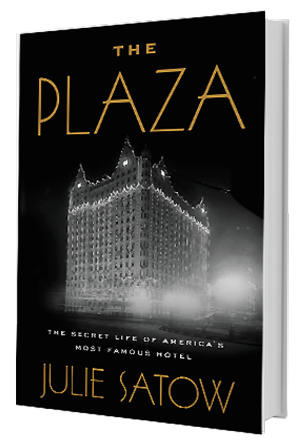 From the moment in 1907 when New York millionaire Alfred Gwynne Vanderbilt strode through the Plaza Hotel’s revolving doors to become its first guest, the 18-story white marble edifice at the corner of Fifth Avenue and 59th Street has radiated wealth and luxury.
From the moment in 1907 when New York millionaire Alfred Gwynne Vanderbilt strode through the Plaza Hotel’s revolving doors to become its first guest, the 18-story white marble edifice at the corner of Fifth Avenue and 59th Street has radiated wealth and luxury.
For some, the hotel evokes images of F. Scott Fitzgerald frolicking in the Pulitzer Fountain, or Eloise, the impish young guest who pours water down the mail chute. But in recent years, foreign money and the condo-ization of the hotel have changed its DNA.
“The Plaza: The Secret Life of America’s Most Famous Hotel” details the storied history of the landmark hotel.
Written by New York Times real estate contributor Julie Satow and published by Hachette’s Twelve imprint, the book goes on sale June 4. (Full disclosure: Satow is married to Stuart Elliott, The Real Deal’s editor-in-chief.)
The following is an excerpt from the book about the sale of the building’s condos during the real estate boom of the mid-aughts.
Like other condominium developers, when owner El Ad began selling the Plaza Private Residences, as the reimagined hotel rooms were called, its chief priority was to generate as large a profit as possible. A team of real estate brokers was hired to accomplish this and their responsibilities included marketing and sales.
Alexa Lambert, an agent at the brokerage firm Stribling, was put in charge of marketing the Plaza’s splashy new condominiums. “I’ve never worked so hard in my life,” she said. For Lambert and her three-person team, pitching the Plaza units was challenging, mostly because they didn’t yet exist. Unlike the grand celebration in 1907 that greeted Vanderbilt, Gates, and other guests on the Plaza’s opening day, in 2005, buyers were introduced to a property that was a complete wreck. Rather than red carpets, claw-foot bathtubs, and arched windows overlooking Central Park, they found a gutted structure filled with dust, loud banging, and a constant crush of construction workers. Potential buyers entering on Fifth Avenue were ushered around mountains of debris and equipment to the corner where Fifth Avenue and Central Park meet. In the space that had once been the Café, the Edwardian Room, and, for a brief time, the Green Tulip, they found a sales office, the room’s dark wood paneling and gracious interiors converted into cubicles and oversized video screens.
 Even with the chaos of construction, and the fact that there were no apartments to see that first day, multiple contracts were sent out to interested buyers and the calendar was already booked with appointments. Colleagues at other brokerage firms who wanted to see the new project complained that their calls weren’t being returned fast enough, and many grew frustrated when their high-profile clients were forced to wait days to get inside. Lambert, a pretty brunette with a friendly smile and a no-nonsense persona, did her best to handle the velocity of calls and appointments. It became so crazy that her harried team started ordering lunch as soon as they arrived in the morning, in the hopes they could find a few minutes to scarf down sandwiches between appointments.
Even with the chaos of construction, and the fact that there were no apartments to see that first day, multiple contracts were sent out to interested buyers and the calendar was already booked with appointments. Colleagues at other brokerage firms who wanted to see the new project complained that their calls weren’t being returned fast enough, and many grew frustrated when their high-profile clients were forced to wait days to get inside. Lambert, a pretty brunette with a friendly smile and a no-nonsense persona, did her best to handle the velocity of calls and appointments. It became so crazy that her harried team started ordering lunch as soon as they arrived in the morning, in the hopes they could find a few minutes to scarf down sandwiches between appointments.
Prospective buyers were willing to spend astronomically on these imagined apartments. Even by the elevated standards of the mid-aughts, when a historic real estate bubble was reaching its peak, the Plaza’s prices were high. If an exclusive Fifth Avenue home was selling for $3 million, at the Plaza a similar unit was asking $5 million; if that Plaza unit overlooked Central Park, it was even more. And absolutely everything was extra: The basement storage bins cost more than $40,000 each; the Plaza’s fitness center was accessible only by shelling out $10,000 in dues before stepping foot on a treadmill; and maid service, provided by the hotel, cost nearly $500 for a full day’s work. “It was hard to understand what a new frontier it was in terms of pricing,” Lambert said. “It was completely new to have a $5 or $6 million one-bedroom. . . It was just nuts.”
At the Plaza, the elevated price tags seemed only to stoke more interest. There were high-powered New York lawyers, Wall Street hedge funders, Hollywood executives, and foreign tycoons who put down deposits on apartments, some sight unseen.
One buyer was driving down a Los Angeles freeway in his convertible when he called the sales center. As the broker struggled to tell him about the different apartments over the din of the traffic and the strong wind, he brushed her off. Instead, the caller decided on the spot to buy a $12 million pad with Central Park views. In another case, a multimillionaire had promised his wife that should he ever become successful, they would live at the Plaza. He called the sales office and ordered her a penthouse for $20 million, with about as much due diligence as if he were ordering Chinese takeout.
Other buyers who did come to the sales center shocked the staid brokers with their behavior. There was one foreigner who arrived with an armed security detail, the guards standing at attention with their guns in full view while he perused the marketing materials. In other instances, buyers inquired if they might not pay with a suitcase of gold; or bags of cash; or half in euros. The brokers told them that real estate sales must be transacted through a lawyer, and the offers were politely declined. Brokers couldn’t accept cash for an apartment, but they could accept buyers without having to check their backgrounds. This proved a problem when a Brazilian woman, for instance, who was in the process of buying several units at the Plaza, was arrested for running a high-priced call girl ring on the Upper West Side; she was sent to prison before the transaction closed.
Lambert and her team of brokers welcomed countless would-be buyers who arrived wearing Prada and dripping with diamonds. But many failed to look the part. Before appointments, the brokers were often frantically googling names to determine who had sufficient financial backing and who was merely window-shopping. One wealthy couple, for instance, owned a car dealership in Ohio. “If I didn’t know better, I would have thought I was being punked by one of my friends,” said one of the Plaza brokers. “The guy had a really bad toupee, and a tacky wife with platinum blond hair. I was like, ‘for real?’” (The couple didn’t end up buying.)
After the appointments, the agents handed out marketing materials to potential buyers, enclosing the brochures either in expensive leather pouches embossed with the Plaza logo or in cheaper linen versions. They took to examining visitors’ shoes to determine who was worthy of the leather pouch, and who the linen: Those with expensive footwear were given the leather cases.
Eventually, the developer had squeezed what value it could from the iconic hotel and walked away with an impressive $1.4 billion from the sales. When the cost of its renovations and other expenses were added in, El Ad claimed a net profit from the entire Plaza project of $1 billion.
— This is a condensed excerpt from author Julie Satow’s new book, “The Plaza: The Secret Life of America’s Most Famous Hotel.”
